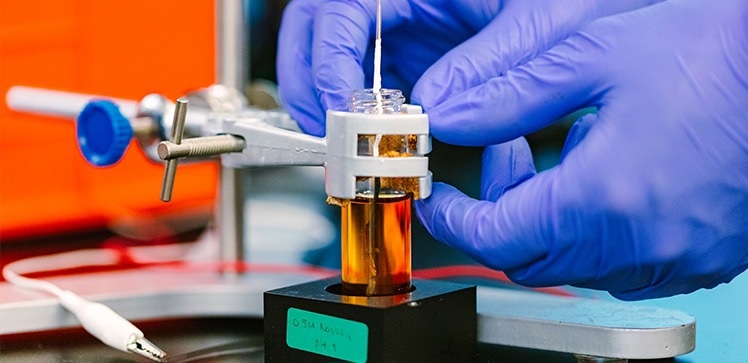Reviewed by Alex SmithAug 3 2022
Molybdenum is the key component in an electrochemical hydride transfer catalyst that was examined by the KAUST researchers, bringing sustainable fuel and chemical manufacturing one step closer to being an actual reality.
 A team of KAUST catalyst scientists have shown how a molybdenum-based catalyst (pictured above) can play a central role in a process pivotal to the sustainable production of renewable energy and green chemicals. Image Credit: Anastasia Serin, KAUST
A team of KAUST catalyst scientists have shown how a molybdenum-based catalyst (pictured above) can play a central role in a process pivotal to the sustainable production of renewable energy and green chemicals. Image Credit: Anastasia Serin, KAUST
For a very long time, platinum has been the preferred catalyst for electrochemical hydride transfer, a chemical process that has the potential to make valuable chemicals or carbon-free fuels.
A more sustainable society could be made possible if this electrochemical process used renewable energy as its power source. However, the use of this technique is severely constrained since platinum is a precious metal that is both scarce and expensive.
Magnus Rueping and his team have demonstrated that molybdenum, a much more plentiful and affordable metal, has the potential to replace platinum in the process.
Molybdenum sulfide and other molybdenum-based catalysts have successfully indicated promise for hydride transfer electrocatalysis, but the cause of their high activity and molybdenum’s function, in particular, remained a mystery.
We wanted to determine how this catalyst functioned.
Jeremy Bau, Research Scientist, King Abdullah University of Science and Technology
To see the molybdenum sulfide electrocatalyst in action in real time, the researchers used a method called electron paramagnetic resonance spectroscopy (EPR).
Bau added, “Unexpectedly, we were able to capture the entire process as it was happening. We were able to trap the catalyst’s active state: Mo3+ ions directly bound to hydrogen.”
The discovery that molybdenum ions directly take part in hydride transfer could result in better catalysts.
“If we can demonstrate a cohesive theory for how molybdenum is responsible for hydride transfer activity, we can focus on improving molybdenum so that it can be competitive with platinum and also on developing new molybdenum catalysts as cheaper replacements for platinum,” added Bau.
One potential use of the catalyst is to electrochemically split water molecules to create hydrogen gas, which can be stored and transported as a fuel. The researchers also demonstrated that the catalyst has enormous potential for improving enzyme biocatalysts for the production of green chemicals.
Enzymes frequently collaborate with NADH, nature’s energy-carrying molecule, to catalyze reactions in cells. However, the price of NADH makes it impractical for industrial biocatalysis. However, molybdenum hydride produced electrochemically turned out to be quite efficient in regenerating NADH in situ in the biochemical reaction flask.
We were surprised by the efficiency of the process. By-products are avoided and pure NADH is produced. Our discovery raises the possibility that the long-held goal of making chemicals through enzymes can be enabled by electrochemistry.
Magnus Rueping, Professor, Chemistry, King Abdullah University of Science and Technology
Molybdenum caught holding the hydrogen
KAUST researchers show how a molybdenum-based catalyst can produce more sustainable fuel and chemicals. Video Credit: © 2022 KAUST; Anastasia Serin.
Journal Reference:
Bau, J. A., et al. (2022) Mo3+ hydride as the common origin of H2 evolution and selective NADH regeneration in molybdenum sulfide electrocatalysts. Nature Catalysis. doi:10.1038/s41929-022-00781-8.